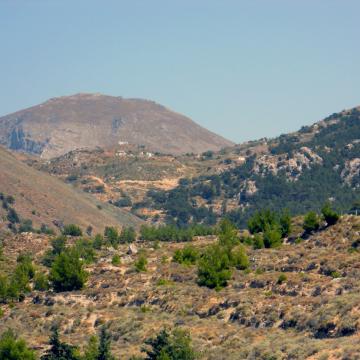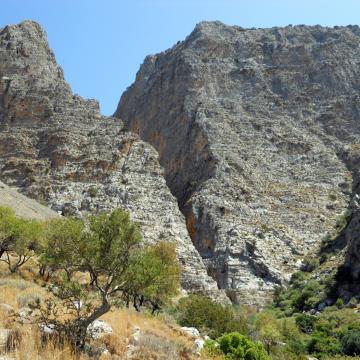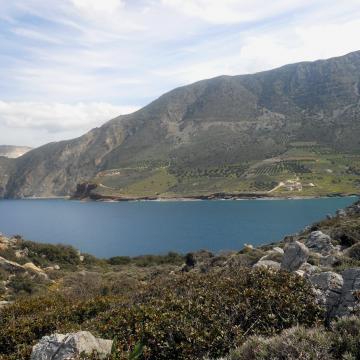GR4320005 - OROS THRYPTIS KAI GYRO PERIOCHI
Map
Quality
The quality and importance of the site "Thrypti" is indicated by the following elements: 1) It is of great aesthetic value, especially its southern slopes; 2) The cave Theriospilios at Tholos area is of great importance because of the presence of both a relatively big colony of the bat Myotis myotis and many endemic invertabrates; 3) The tops of the mountain are very important for the avifauna of Crete, because of the presence of both a relatively big colony of the bat Myotis myotis and many endemic invertebrates; 4) Its flora is rich in common and endemic species which are of great interest as most of them are endemic to the site or to the island. Tle plants Campanula hierapetrae, Helichrysum doerfleri and Minuartia wettseinii are exclusively endemic to Thrypti mountain and Eryngium amorginum is an endemic to the islands of Amorgos and Crete, only to be fould at Thrypti in the later. Its fauna is rich in endemic invertebrates and it also includes two snails, Albinaria sturanyi and Albinaria teres, which are local endemics to the site; 5) the mamals populations are in excellent condition due to both the geomorphology of the site and to the limited human presence and impact; 6) There is a variety of quite well conserved habitats in a relatively small area, which are not very easy to access, in most of the site; 7) The pine forest is one of the few in Crete; however, it has been burnt twice (12 and 2 years ago) without having a chance for sufficient regeneration until now. OTHER IMPORTANT SPECIES WITH MOTIVATION DThe following species are protected by the Greek Law (Presidential Decree 67/81) and are included in the IUCN Red Data List (1993) in the category of threatened plants: Cotoneaster nummularia (vulnerable), Anthemis abrotanifolia (rare)Tulipa saxatilis is protected by the Greek Law (Presidential Decree 67/81).Barlia robertiana, Ophrys sphegodes ssp. cretensis, Orchis anatolica ssp. sitiaca and Limodorum abortivum are protected by the CITES Convention (Annex C). Orchis anatolica ssp. sitiaca, Ophrys sitiaca, Ophrys sphegodes ssp. cretensis Ophrys basilissa are protected by the Greek Law (Presidential Decree 67/81).Arum creticum is a species with distribution in Crete and the East Aegean found only in SW Turkey out of Greece. Helichrysum orientale Iia a species with distribution in Greece and W Turkey. Lactuca acanthifolia (= Scariola acanthifolia) is found in Ydra, Cyclades, East Aegean Islands andonly in SW Turkey out of Greece. Euphorbia dimorphocaulon is a mediterranean species with distribution in Crete S Turkey and Cyprus.
Other characteristics
The site is located between the towns Ierapetra and Sitia at the eastern part of Crete. It includes the coastal area of Tholos and the mountain range of Thrypti with its peaks: Afentis (1476 m), the highest peak, and surrounding it the peaks Kapsa (997 m), W. Papoura (1010 m), Koufoto (912 m), Katalymata (802 m), and E. Papoura (1187 m). The main characteristics of the site are: 1) inland cliffs, chasms, screes, and gorges; Cha gorge is one of the most impressive gorges in Crete; The dolines of the site are of special interest; the wet dolines are characterized by scanty vegetation of annuals common in other places but rare in Crete while the dry dolines are characterized by dense vegetation and, in Afentis Kavousi, by the occurence of Polygonum idaeum, specialized in this type of habitat and confined to Psiloritis and Dikti; 2) dolomites near the top Afentis and limestones at the rest of the site; 3) phrygana, affected by grazing; 4) a pine forest of Pinus brutia with very old trees (the oldest one is about 250 years old). The major part of this forest was burnt 12 years ago; 5) small valleys and plains are formed among the mountain slopes and they are cultivated with vineyards; 6) small valleys with springs and rivers of constantly running water and riparian galleries and thickets, at the southern part of the site; 7) locally restricted building activities and minor roads. NOTES8140 describes Aegean Mediterranean screes of high altitude (tAegean screes of Crete, Corine code 61.415) and screes of low altitude with predominantly annual plants and with some perennials, such as Clematis cirrhosa.
Documentation
1) 3.2.c, 3.3., 4.1., 4.2., 4.3.:
1) CORINE-MEDSPA Database (especially for 4.2., avifauna).
2) Hellenic Zoological Society - Hellenic Ornithological Society. 1992. The red data book of threatened vertebrates of Greece. Athens.
3) Turland N.J., Chilton L., Press J.R. 1993. Flora of the Cretan area. London: HMSO.
4) Sowig, P. 1985. Beitrage zur Kenntnis der Verbeitung und Okologie der Amphibian und Reptilien Kretas. Salamandra 21(4): 252-267.
5) Vardinoyannis K. 1994. Biogeografia ton chersaion malakion sto notio nisiotiko Aigaiako toxo (Biogeography of land snails in the south Aegean island arc). Ph.D. Thesis. Athens University.
6) Filippakis M. 1992. Geniko schedio dasoponikis anaptyksis tou nomou Lasithiou (General pattern of forestry development in the province of Lasithi. General Forest Directorate.
7) Valakos E. Unpublished data.
8) Kypriotakis Z. Unpublished data.
9) Paragkamian K. Unpublished data (3.3., 4.2., endemic invertebrates).
10) Egli B.R. 1991. The special flora, ecological and edaphic conditions of dolines in the mountains of Crete. Bot. Chron. 10:325-335.
11) Georghiou K. 1995. Checklist of Endemic, Rare and Threatened Plants of Greece. Draft. University of Athens. (3.3, 3.4, 4.2)
12) Morgan V & C. Leon. 1992. Datasheets of Flora species for revision of Appendix I of the Bern Convention. Volume IV. endemic taxa of Cyprus, Greece and Turkey Nature and environment. Nature and Envrionment. No 63 p. 106. Council of Europe, Publishing and Documentaion Service, Strasbourg. (3.2.g.)
Reference: Natura 2000 data form, database release 7 Feb 2014





